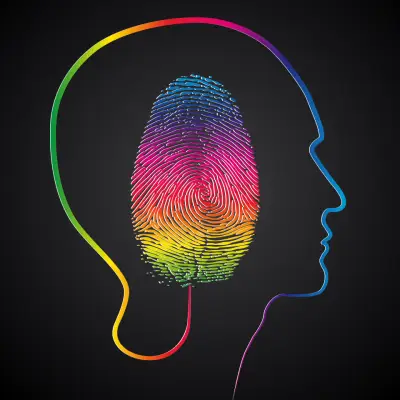If you're reading this, you might be trying to understand what it means to be a "favourite person" for someone with Borderline Personality Disorder (BPD). You could be supporting a loved one, looking for insights into your own behaviour, or simply curious about this concept. Read more to find out what a BPD favourite person is, the dynamics involved, and how it affects relationships.
Jump To:
- What is Borderline Personality Disorder (BPD)?
- What is a BPD Favourite Person?
- The Dynamics of a Favourite Person Relationship
- The Impact of a Favourite Person Relationship on the Favourite Person
- Coping Strategies for the Favourite Person
- Common Questions About BPD Favourite Person Relationships
- Study Borderline Personality Disorder for £29
What is Borderline Personality Disorder (BPD)?

Borderline Personality Disorder (BPD) is a mental health condition characterised by intense emotional experiences and instability in moods, behaviour, self-image, and relationships. People with BPD often experience extreme emotions and have difficulty managing them. This can lead to impulsive actions and problems in relationships.
What is a BPD Favourite Person?
A "favourite person" (often abbreviated as FP) in the context of BPD is someone who holds significant emotional importance to the person with BPD. This person often becomes the central figure in their life, and their actions, presence, and opinions can greatly influence the emotional state of the person with BPD.
Recommended for you!
Best SellersThe Dynamics of a Favourite Person Relationship

1. Intense Attachment
The attachment to the favourite person is often very strong. The person with BPD may rely heavily on their FP for emotional support and validation. This can lead to a deep emotional bond, but also to high expectations and dependency. The FP becomes the central figure in their life, often holding a unique and powerful role.
This reliance can mean that any perceived withdrawal or lack of attention from the FP can result in significant emotional distress. It's not uncommon for a person with BPD to seek constant reassurance and attention, which can place a considerable burden on the FP.
2. Idealisation and Devaluation
People with BPD may swing between seeing their FP as perfect (idealisation) and feeling deeply disappointed or angry with them (devaluation). This is often referred to as splitting and can be very confusing and stressful for both parties.
Idealisation can manifest as intense admiration and placing the FP on a pedestal, viewing them as the ultimate source of support and understanding. However, any perceived slight or failure to meet expectations can lead to rapid devaluation, where the FP is suddenly seen as untrustworthy or uncaring. These shifts are not about the FP's actual behaviour but rather the intense emotional responses and fears of the person with BPD.
3. Fear of Abandonment
A common symptom of BPD is an intense fear of abandonment. This fear can be particularly pronounced with the favourite person, leading to behaviours aimed at preventing perceived or real abandonment.
The person with BPD may become overly vigilant about any signs that the FP might leave or distance themselves. This can result in clinging behaviour, frequent calls or messages, and sometimes even testing the FP's commitment through provocative actions or declarations. The fear of abandonment is often rooted in past experiences of loss or instability and can be exacerbated by the intense attachment to the FP.
4. Emotional Intensity
Emotions can be very intense in these relationships. The favourite person's actions can have a powerful impact on the emotional state of the person with BPD, leading to significant mood swings. A simple gesture of kindness can lift their mood dramatically, while a perceived slight can plunge them into despair.
This intensity means that the FP's everyday actions and words are often scrutinised and can be misinterpreted. The emotional volatility can make the relationship feel like a rollercoaster, with highs of intense connection and lows of deep distress.
5. Dependency and Autonomy
The relationship often swings between the person with BPD feeling deeply dependent on their FP and experiencing moments where they seek autonomy. This push-pull dynamic can be exhausting for both parties.
On one hand, the person with BPD may want to feel independent and capable, but on the other hand, their need for the FP's reassurance and support can override these desires. Balancing dependency with the need for personal space and autonomy is a challenge in these relationships.
6. Trust and Mistrust
Trust can be a major issue in the relationship between someone with BPD and their FP. While the person with BPD may desperately want to trust their FP, past experiences and intense fears can lead to mistrust.
This mistrust can manifest in accusations, suspicion, and constant questioning of the FP's loyalty and intentions. Building and maintaining trust requires patience, consistency, and reassurance, which can be challenging given the emotional ups and downs.
7. Communication Challenges
Effective communication is essential but often difficult in these relationships. The person with BPD may struggle to express their needs and emotions clearly, leading to misunderstandings. The FP may also find it hard to communicate their own needs and boundaries without triggering feelings of rejection or abandonment in the person with BPD.
Learning to communicate openly and honestly, while being mindful of each other's emotional states, is essential for the health of the relationship.
The Impact of a Favourite Person Relationship on the Favourite Person
Being someone's favourite person often comes with a great deal of responsibility and pressure. Here are some potential impacts:
Emotional Burden
Carrying the emotional weight of someone with BPD can be exhausting. The favourite person might feel responsible for the other's emotional well-being, leading to stress and burnout.
Confusion and Stress
The cycles of idealisation and devaluation can be confusing and stressful. The favourite person might struggle to understand the intense emotional reactions and mood swings.
Boundaries and Personal Space
Maintaining boundaries can be difficult. The need for constant reassurance and communication can infringe on the favourite person's personal space and time.
Coping Strategies for the Favourite Person

If you find yourself in the role of a favourite person, here are some strategies to manage the relationship healthily:
- Set Clear Boundaries: Establishing and maintaining clear boundaries is essential. Communicate your limits clearly and consistently to avoid burnout and maintain a balanced relationship.
- Encourage Professional Help: Support your loved one in seeking professional help. Therapies like DBT are specifically designed to help people with BPD manage their emotions and improve their relationships.
- Practise Self-Care: Prioritise your own well-being. Engage in activities that help you relax and recharge. It's essential to take care of your mental and emotional health.
- Educate Yourself: Understanding BPD can help you navigate the relationship better. Knowledge about the condition can foster empathy and provide strategies for effective communication and support. If you’d like to learn more, we offer a Borderline Personality Awareness Course for just £29.
Common Questions About BPD Favourite Person Relationships
Do Borderlines Choose Their Favourite Person?
The selection of a favourite person isn't usually a conscious choice. It often happens naturally based on the emotional connection and the level of support perceived by the person with BPD. The FP can be a friend, family member, romantic partner, or even a therapist.
How Do Borderlines Treat Their Favourite Person?
Treatment of the favourite person can vary. On one hand, they might be treated with immense affection, admiration, and attention. On the other hand, when feelings of betrayal or abandonment arise, the favourite person might face anger, criticism, or withdrawal.
What Happens When Someone with BPD Loses Their Favourite Person?
Losing a favourite person can be devastating for someone with BPD. It can trigger intense emotional pain, feelings of emptiness, and abandonment fears. This loss might lead to severe mood swings, depression, or even self-harm in some cases.
Can You Stop Having a Favourite Person in BPD?
It's challenging but not impossible to stop having a favourite person. Therapy, particularly Dialectical Behaviour Therapy (DBT), can help people with BPD develop healthier relationship patterns and reduce their dependency on a single person for emotional stability. Building a broader support network can also be beneficial.
What Are the Signs That You Are Someone's Favourite Person?
Signs that you might be someone's favourite person include receiving an unusually high level of attention and emotional reliance from them. You might notice that their mood significantly changes based on your interactions and that they often seek your validation and support. They might also express fears of you leaving them or frequently check in with you for reassurance.
How Can You Support Someone with BPD Without Becoming Their Favourite Person?
Supporting someone with BPD without becoming their favourite person involves setting clear boundaries and encouraging them to build a wider support network. It's important to offer consistent support while also promoting their independence. Encouraging them to engage in therapy and to develop coping skills can also help in maintaining a balanced relationship.
Can Multiple People Be Favourite Persons?
It's possible for someone with BPD to have multiple favourite persons, though typically one person may hold a primary position. The individual might have several people they rely on for different types of support, but the intensity of attachment might vary with each person.
What is the Role of a Therapist in Managing Favourite Person Relationships?
Therapists play an important role in helping individuals with BPD understand and manage their feelings toward their favorite person. Through therapy, people can learn to develop healthier attachment styles, improve emotional regulation, and build more stable relationships. Therapists can also provide guidance and support to the favorite person, helping them navigate the complexities of the relationship.
How Can Favourite Persons Encourage Healthy Behaviours in Someone with BPD?
Favourite persons can encourage healthy behaviours by reinforcing positive actions, providing gentle and consistent support, and avoiding enabling unhealthy behaviours. Encouraging the person to engage in therapy, practise self-care, and build a broader support network can foster a healthier relationship dynamic. It's also helpful to model healthy emotional regulation and communication skills.
Recommended for you!
Best SellersStudy Borderline Personality Disorder for £29
If you're interested in learning more about Borderline Personality Disorder and how to support someone with BPD, consider taking the Borderline Personality Awareness Diploma Course with Centre of Excellence. This detailed course offers valuable insights and practical strategies for managing BPD. By following the link, you can access the course at a discounted price of £29.













